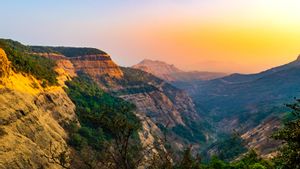It was German-born American psychoanalyst Erich Fromm who first coined the term ‘biophilia’ as a scientific hypothesis in his 1973 work The Anatomy of Human Destructiveness. Today, it has come to denote the innate instinct of humans to connect with nature and other living beings.
Experts feel that it is the new ‘post-pandemic rush’ to see all and do all that has exacerbated the need to seek out biophilia. “Due to our new hectic lives, we really don’t get the time to connect with nature. This is why, these days, interior designers and architects are consciously incorporating the biophilia concept in their design. As it illuminates the aesthetic sense and connects one more with nature,” says Pune-based interior designer Hirtika Chopra.
Of a similar belief is Thane-based architect Mosho Baba. “Biophilia does not mean to just visually make everything look green. Instead, it has a lot to do with respecting the natural elements like the micro-climate, the terrain of the site, the geographical context and designing with these elements of nature,” explains Baba.
“Biophilia is a great way to bring nature into a living space, be it a home or hotel, as it applies a very basic human-centric ethos to design,” believes Renil Fernando, a Colombo-based urban planner. “We see it touching on different aspects of hospitality, from adopting eco-conscious practices, construction and even F&B with the whole hyper-local consumption concept taking root.”
To that end, the following hotels and resorts are prime examples of how biophilia is the hospitality world’s new buzzword. All, with a smidgen of luxury on the side...
1. The Westin Resort & Spa Himalayas, Narendra Nagar, Uttarakhand

Sharing a certain affinity with its natural surroundings, this new resort and spa that opened in late January this year lies perched on 12 acres of lush green mountainside overlooking the magnificent Shivalik ranges of the Himalayas, with the city of Rishikesh below. Built into the craggy rock face of the mountain, the resort has plenty of local rock and stone used in its construction. It is no great surprise then, that the architecture and location of the hotel are inspired from the concept of biophilia. Here, one is made aware of the subtle concentric circle pattern in the hotel’s decor elements. Inspired by the circles formed by a drop of water, one sees them on the plush taupe-coloured carpet you walk over in the resort’s gargantuan yet minimalist lobby. Circles hang overhead in the chandelier made up of several cane baskets. Coffee tables here are cross-sections of tree trunks with the concentric age circles of the wood, pat in place.
2. Wild Coast Tented Lodge, Yala National Park, Sri Lanka

From its pod-like rooms that resemble silkworm cocoons and a clever layout in the shape of a leopard’s paw print, this resort channels biophilia with all its might. Situated in a unique location where the Yala National Park meets a pristine beach, overlooking the blue waters of the Indian Ocean, this property is a member of the Relais & Châteaux group. Here, man-made structures blend seamlessly into the surrounding landscape with the distinctive rock formations of Yala. This, thanks to the use of carefully selected natural materials. The use of arched fabric structures allows each of the twenty eight cocoon pod tents to take on the contours and colour of the rocks and boulders that lay scattered nearby. Even the open-air bamboo-clad bar and dining pavilion is designed to mirror the boulders strewn across the golden-sanded beach beyond. Moving on from its design, even its basic premise is steeped in nature and the conservation therefore. This means, water is desalinated from the ocean and recycled into watering holes for animals to drink from, a solar plant meets energy needs, and organic waste is composted on site. Furthermore, the lodge is building a Leopard and Climate Change Research Station next to the property for a more ‘hands on’ experience of what it takes to be one with nature in these parts.
3. SAii Phi Phi Island Village, Koh Phi Phi, Thailand

At this beach resort, housed on a secluded section of the Koh Phi Phi Island along Thailand’s Andaman Coast, there is a concerted effort to be one with nature. From the Len Forest Spa that’s built into the mountain, resembling a cosy tree house, to the locally built thatched roof and walled guest bungalows, the emphasis on biophilia here is very evident. The resort even has its own Marine Discovery Center that offers guests lessons in marine conservation along with its bamboo shark breeding programme. Additionally, the resort is almost self-sufficient as it produces and glass bottles its own RO drinking water. Besides recycling 100% of its wastewater, which is treated and used to nourish the gardens and trees.
4. Mary Budden Estate, Binsar, Uttarakhand

Nestled in the breath-taking natural surroundings of a wildlife sanctuary, the Mary Budden Estate is biophilia personified. An idyllic haven that’s even older than the Binsar Wildlife Sanctuary that it now finds itself wedged into. Spread over five acres of land, the estate is made up of the main Mary Budden cottage and four independent lodges. Built in harmony with nature using local deodhar (cedar) wood, and slate for the roofs, the cottages at the estate offer tastefully appointed rooms with logwood fireplaces (called bukharis in the Kumaoni language) and stone patios. Hand-picked antique furniture, with local fabrics and embroidery complete the rustic look.
5. Cape Weligama, Weligama, Sri Lanka

As its name suggests, this property, that is also a part of the Relais & Châteaux portfolio, inhabits twelve tropical acres atop a singular promontory above the Indian Ocean on Sri Lanka’s southern coast, in the terracotta pottery village of Kumbalgama. Offering a sweeping, 270-degree view of the cape’s edge, this property does its bit to propagate the concept of biophilia in myriad ways. To begin with, its collection of 39 villas and suites is modelled on the concept of a traditional Sri Lankan village. Replete with local terracotta-tiled rooftops and surrounded by beautiful basalt stone ringed gardens that are inhabited by a bunch of peacocks who rouse you out of bed with their early morning “wake up calls”! The food on offer here blends local ingredients like gotukola (pennywort) and the ambarella (hog plum) with international presentations. Even the spa offers treatments featuring organic home-grown Sri Lankan spice scrubs made from clove, nutmeg, sweet orange and sandalwood. For some local adventure, why not try scuba diving, take surfing lessons or do a spot of rice paddy bicycling. The offsite free kindergarten powdered by the MJF Foundation—that’s a sister concern of the resort—is the perfect place to interact with the lively toddlers of Kumbalgama.
6. Club Mahindra Munnar, Munnar, Kerala

Set amidst a working tea estate, with cascading waterfalls and the endless lagoons of Munnar at its doorstep, this property featuring a polished teak lobby, logwood cabins and stone fireplaces is an example of how biophilia can be incorporated with luxury. Tea is such an intrinsic part of life here that even the on-site spa has an entire menu of therapies that use tea leaves and tea tree oils in them. Speaking of the spa, this standalone building is constructed with local timber and has a unique inner false ceiling made from terracotta tiles. For activities, nature walks, treks to the aforementioned waterfalls and bonfire camping on the rolling hills is arranged by the resort’s activities team.
7. Hilton Maldives Amingiri Resort and Spa, North Malé Atoll, The Maldives

Featuring a total of 109 villas including the beach and overwater villas, the accommodation options here are furnished in a refreshing colour palette that reflects the warm hues of the sky and shore. You will find locally inspired accents and artwork everywhere you look. Even the spa here has all its therapy rooms named after the island’s local flowers. The restaurants and lounges have elongated domed roofs that resemble an upturned hull of a traditional dhoni fishing boat. This leaning towards nature shows up in the behind-the-scene activities, too. The resort collaborates with local partners on recycling, wastewater treatment, and eliminating single-use plastic to protect marine life. They also claim to take a thoughtful approach to dining by minimising food waste and sourcing locally as much as possible.
8. Ceylon Tea Trails, Hatton, Sri Lanka

As the world’s first tea bungalow resort, perched at an altitude of 1,250 metres in Sri Lanka’s panoramic Ceylon tea region, this property channels biophilia like no other. From its setting in the midst of a working tea estate to its location that borders the UNESCO World Heritage Central Highlands, Tea Trails is the first Relais & Châteaux resort in Sri Lanka. Spread across five restored colonial-era tea planters’ bungalows, nature is not just at your doorstep but on your plate too. The curated tea dinner is an elaborate four-course affair with everything from cocktails to mains and even dessert flavoured with the aromatic local Ceylon tea.
Photo: Featured Brands




